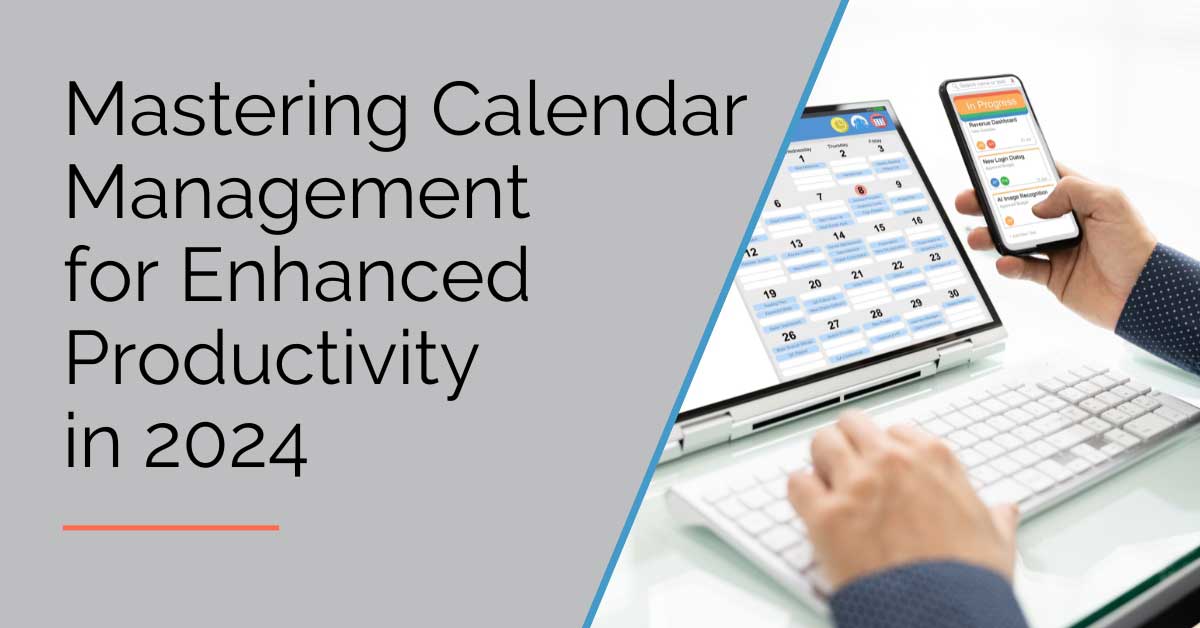Exploring Comprehensive Strategies for Optimizing Calendar Management
This blog will provide a thorough examination of the strategies and tools available for optimizing calendar management in the year 2024 and beyond.
From understanding the power of saying “No” to leveraging technology and virtual assistants, we will explore methods that can streamline your schedule, making it more productive and less overwhelming.
Whether you’re a busy executive, an entrepreneur, or anyone in between, mastering these strategies can lead to significant improvements in how you manage your time.
By integrating virtual assistants into your calendar management strategy, you can ensure that your schedule reflects your priorities accurately, allowing for a smoother execution of daily tasks and long-term projects. This blog will guide you through the nuances of making the most of your time, ensuring that every minute counts towards building a more organized, efficient, and fulfilling life.
Join us on this journey to master the art of calendar management, unlocking the potential for remarkable professional and personal growth along the way.

The Foundations of Calendar Management
Effective calendar management is built upon a deep understanding of two fundamental concepts: the value of time and the pitfalls of overcommitment. By grasping these foundational principles, professionals can enhance their efficiency, reduce stress, and make significant strides in both their personal and professional lives.
Understanding the Value of Time
Time, unlike other resources, is irreplaceable and finite.
Every day presents a limited number of hours to pursue our goals, making it imperative to use this resource wisely. Recognizing the value of your time is the first step towards transforming your approach to work and life.
This recognition encourages a shift from being merely busy to being genuinely productive, focusing on tasks that align closely with your objectives and personal values.
The impact of valuing time on professional efficiency cannot be overstated. It leads to better decision-making about which meetings to attend, which projects to prioritize, and how to allocate resources effectively.
Virtual Assistants can play a crucial role in this context by taking on the task of scheduling and time management, ensuring that your calendar reflects your priorities accurately.
With a VA’s support, professionals can dedicate more time to strategic thinking and high-value activities, maximizing the return on their time investment.

The Pitfalls of Overcommitment
Overcommitment is a common challenge in calendar management, stemming from an eagerness to take on too much, too soon.
It often leads to decreased productivity and increased stress, as the quality of work diminishes under the pressure of unrealistic schedules. The key to avoiding overcommitment lies in understanding that not all tasks and meetings are created equal.
Quality, rather than quantity, should guide your commitments.
Learning to say “no” is an essential skill in this regard. It involves making tough choices about which opportunities to pursue and which to pass on, based on their alignment with your long-term goals and the value they add to your professional growth.
Virtual Assistants can be instrumental in managing these decisions by helping to filter requests and commitments according to predefined criteria, managing your calendar to avoid overbooking, and ensuring that there is ample time for high-priority tasks.
Balancing commitments effectively requires a keen understanding of your limits and a strategic approach to scheduling. By prioritizing tasks that offer the greatest impact and delegating or declining those that do not align with your goals, you can maintain a healthy balance between work and personal life.
Virtual Assistants facilitate this balance by handling the administrative aspects of calendar management, allowing you to focus on what truly matters.
The foundations of effective calendar management lie in recognizing the value of time and understanding the dangers of overcommitment. By prioritizing tasks that align with your objectives and leveraging the support of Virtual Assistants, you can optimize your schedule for maximum efficiency and stress reduction.
This strategic approach to time management sets the stage for improved productivity and a more fulfilling professional journey.

The Art of Prioritization
Mastering the art of prioritization is a critical skill in effective calendar management. It involves making informed decisions about where to focus your energy and resources to maximize impact and productivity.
This section explores the power of saying “No” and the methods for identifying high-impact activities that drive progress and growth.
The Power of Saying ‘No’
One of the most empowering aspects of prioritization is learning the power of saying “No.”
It’s a crucial skill that protects your time, allowing you to concentrate on commitments that align with your goals and values. Assessing the value and relevance of commitments is the first step in this process.
Ask yourself whether a potential commitment will move you closer to your objectives or if it merely serves as a distraction.
Practical techniques for politely declining requests can include expressing gratitude for the opportunity, providing a brief explanation for your decision, and if possible, offering an alternative solution or referral.
Virtual Assistants (VAs) can be invaluable in this context, managing communication on your behalf and ensuring that declines are handled professionally and tactfully. They can also assist in evaluating requests based on predetermined criteria, helping you stay focused on your priorities.

Identifying High-Impact Activities
Not all tasks are created equal. Identifying high-impact activities — those that significantly contribute to your goals — is essential for effective prioritization.
This involves a systematic evaluation of tasks based on their potential benefits and alignment with your strategic objectives.
Techniques such as the Eisenhower Box, which categorizes tasks into urgent/important matrices, and the Pareto Principle, suggesting that 80% of results come from 20% of efforts, can guide this process.
Virtual Assistants play a pivotal role in implementing these prioritization methods. They can help set up and manage tools that track and categorize tasks, ensuring that you are focusing on activities with the highest return on investment.
Additionally, VAs can take on lower-priority tasks themselves, freeing up your time for work that only you can do and that has the greatest impact on your success.
Effective prioritization is not just about filtering out less important tasks; it’s about ensuring that your calendar reflects your most significant goals and commitments.
By mastering the art of saying “No” and identifying high-impact activities, you can optimize your productivity and advance towards your objectives more efficiently.
Virtual Assistants are key allies in this journey, offering the support needed to maintain a focus on what truly matters, ensuring that every day is a step towards achieving your ambitions.
Effective Calendar Strategies
Optimizing your calendar is about more than just filling in slots; it’s about implementing strategies that maximize focus, productivity, and well-being.
This section explores two powerful techniques: time blocking for enhanced focus and productivity, and balancing commitments to align with your broader personal and professional goals.

Time Blocking: Maximizing Focus and Productivity
Time blocking is a strategic approach to scheduling where you allocate specific blocks of time to tasks or groups of tasks. This method transforms your calendar from a simple to-do list into a structured plan that prioritizes deep work and minimizes distractions.
By dedicating set periods to focused work, you create an environment where productivity thrives. This approach is especially effective for tasks that require concentration and creativity, as it ensures uninterrupted time to dive deep into your work.
Integrating buffer times within your schedule is an essential aspect of effective time blocking. These are short periods set aside between tasks or appointments, providing flexibility and reducing stress. Buffer times account for the inevitable overruns and offer moments to reset and prepare for the next activity.
They act as a safeguard against the day’s unpredictability, ensuring that your schedule remains realistic and manageable.
Virtual Assistants (VAs) can significantly enhance the effectiveness of time blocking by managing the intricacies of your calendar.
They can schedule tasks according to priority, ensure adequate buffer times are included, and adjust your calendar as needed to accommodate changes, allowing you to stay focused on high-value activities.

Balancing Commitments with Personal and Professional Goals
A well-managed calendar reflects not just your professional commitments but also your personal goals and values.
Balancing these elements requires a deliberate approach to scheduling that aligns your time investment with your overarching objectives. This balance is crucial for long-term success and well-being, as it ensures that your professional achievements do not come at the expense of personal fulfillment.
Flexibility plays a critical role in this process, allowing you to adapt to unexpected opportunities and challenges.
A flexible schedule accommodates changes without causing disruption, enabling you to respond to new information or urgent tasks while maintaining progress toward your goals.
It’s about creating a dynamic balance that supports growth in all areas of your life.
Virtual Assistants are invaluable in achieving this balance. They can help align your calendar with your personal and professional goals, ensuring that commitments are scheduled in a way that supports overall well-being.
VAs can also monitor your schedule for potential conflicts or overcommitments, suggesting adjustments as necessary to maintain the right balance.
Incorporating these effective calendar strategies into your routine can dramatically improve how you manage your time.
Time blocking and balancing commitments ensure that every day moves you closer to your goals, with the support of Virtual Assistants enhancing your ability to stay focused, productive, and aligned with your values.

Tools and Technologies for Calendar Efficiency
The right tools and technologies can transform your approach to calendar management, making it easier to organize, prioritize, and adapt your schedule to meet both personal and professional demands.
This section explores the variety of calendar management tools available and how to tailor them to your personal work style for maximum efficiency.
Overview of Calendar Management Tools
With calendar management, there are two primary categories of tools: digital and physical.
Digital calendar tools, such as Google Calendar, Microsoft Outlook, and Apple Calendar, offer a range of functionalities including event reminders, recurring appointments, and the ability to share calendars with others.
They’re accessible across multiple devices, making them ideal for on-the-go professionals who need to keep their schedules at their fingertips.
Physical calendar tools, like planners and wall calendars, appeal to those who prefer a tangible approach to schedule management. They allow for a visual overview of your month or week at a glance and can be particularly effective for people who benefit from physically writing down their commitments.
Personalizing these tools to fit individual scheduling needs is crucial.
Digital tools often allow for extensive customization, such as color-coding for different types of tasks or integrating with other productivity apps.
Finding the right mix of features that cater to your specific needs can significantly enhance your calendar’s effectiveness.

Integrating Tools with Personal Work Style
Customizing calendar management tools requires an understanding of your personal work style and the unique challenges you face, such as overbooking or managing unpredictable changes.
Digital calendars can be tailored with alerts to prevent double-booking and reminders for upcoming tasks, which are essential for staying on top of a busy schedule. Features like time blocking or priority tagging can help you focus on high-impact activities.
However, even the most sophisticated tool can’t manage your schedule on its own.
This is where Virtual Assistants (VAs) come into play. They can leverage these tools to manage your calendar more effectively, applying their understanding of your priorities and preferences to schedule tasks, meetings, and personal time.
VAs can also adjust your schedule in real-time to accommodate last-minute changes, ensuring that your calendar remains a true reflection of your priorities.
In addition, VAs can help overcome common challenges by setting up and maintaining your calendar management tools, from inputting data to ensuring that all your devices are synchronized.
They can monitor your schedule to prevent overcommitment and ensure that buffer times are included for transitions or unexpected tasks.
Integrating calendar management tools with your personal work style, supported by the expertise of a Virtual Assistant, can dramatically increase your productivity and efficiency.
By customizing these tools to meet your unique needs and challenges, you create a powerful system that keeps you focused, flexible, and aligned with your goals.
This strategic approach to calendar management ensures that you are always in control of your time, enabling you to achieve more with less stress.

Real-World Application and Benefits
The theoretical aspects of calendar management come to life through real-world applications, demonstrating benefits and lessons learned.
This section explores success stories and the long-term advantages of adopting a streamlined approach to managing your schedule.
Case Studies: Success Stories in Calendar Management
Case Study 1: The High-Performing Executive
A high-performing executive at a technology firm struggled with balancing strategic planning and daily operational tasks.
After implementing time blocking and delegating calendar management to a Virtual Assistant (VA), they were able to dedicate specific blocks for deep work, leading to a 40% increase in productivity. The VA also managed communications, ensuring that only essential meetings were scheduled. This strategic approach allowed the executive to focus on high-impact activities, driving significant growth for the firm.

Case Study 2: The Overwhelmed Entrepreneur
An entrepreneur running a startup found themselves overwhelmed by the sheer volume of tasks, leading to burnout. By prioritizing tasks based on impact and urgency and using digital tools for reminders and scheduling, they regained control of their time.
A VA was instrumental in filtering opportunities and managing the entrepreneur’s calendar, resulting in improved focus, better decision-making, and a healthier work-life balance.
Lessons Learned
These case studies highlight the importance of recognizing one’s limits and the value of saying “No” to commitments that do not align with strategic goals.
They also underscore the benefits of leveraging Virtual Assistants and digital tools for efficient calendar management.
Long-Term Benefits of Streamlined Calendar Management
Effective calendar management is not just about navigating through the week; it’s about laying the groundwork for long-term productivity and achieving a sustainable work-life balance.
A well-managed calendar leads to consistent high performance, enabling professionals to meet and exceed their objectives while maintaining personal well-being.

Continuous Improvement and Adaptation
The journey toward optimal calendar management is ongoing. It requires regular evaluation of what’s working and what isn’t, openness to new strategies and tools, and flexibility to adapt to changing priorities and demands.
This continuous process of improvement ensures that your approach to time management evolves alongside your personal and professional growth.
Virtual Assistants play a pivotal role in this adaptive process, offering insights and support to refine scheduling practices over time. They help identify patterns that may indicate overcommitment or misalignment with goals and suggest adjustments to enhance efficiency and effectiveness.
Achieving Balance
The ultimate benefit of streamlined calendar management is the achievement of a harmonious balance between professional responsibilities and personal aspirations.
By effectively managing your time, you create space for growth, creativity, and relaxation, contributing to overall happiness and fulfillment.
The real-world applications of effective calendar management strategies reveal their significant impact on productivity and well-being. The continuous process of learning, adapting, and refining these practices is essential for sustained success.
With the support of Virtual Assistants and the right tools, professionals can master their schedules, unlock their full potential, and enjoy a balanced, rewarding life.

Final Thoughts
As we conclude this 2024 exploration of effective calendar management, it’s clear that mastering this skill set can profoundly transform both professional productivity and personal well-being.
The journey through understanding the value of time, the art of prioritization, effective calendar strategies, leveraging tools and technologies, and real-world applications has illuminated the path to a more organized, efficient, and fulfilling life.
The strategies discussed aren’t theoretical; they are practical, actionable steps that can significantly impact your daily life.
I encourage you to integrate these strategies into your professional routines, starting with a small change, like time blocking your most critical tasks or delegating calendar management to a Virtual Assistant.
Small steps can lead to big changes, transforming how you approach your time and priorities.
Embrace Anequim’s Expertise
In the pursuit of optimized calendar management and a harmonious work-life balance, you don’t have to go it alone.
Anequim’s expert remote professional services are designed to support you in mastering these strategies. Our Virtual Assistants can take the burden of calendar management off your shoulders, allowing you to focus on what truly matters—your professional growth and personal fulfillment.
Let Anequim guide you in refining your time management skills for lasting success. By embracing our services, you’ll unlock your potential for a more organized, efficient, and satisfying professional journey. Don’t let another day be lost to inefficiency and overwhelm.
Contact us today, and take the first step towards mastering your calendar and transforming your life.

Frequently Asked Questions (FAQs)
What is calendar management?
Calendar management involves organizing and prioritizing your commitments, tasks, and events in a calendar to optimize your time and productivity. It includes scheduling, time blocking, setting reminders, and balancing professional and personal life commitments.
Why is effective calendar management important?
Effective calendar management is crucial for maximizing productivity, reducing stress, and ensuring that time is spent on activities that align with personal and professional goals. It helps in avoiding overcommitment and achieving a harmonious work-life balance.
How can saying ‘No’ improve calendar management?
Saying ‘No’ allows you to decline tasks and commitments that do not align with your priorities or contribute significantly to your goals. It helps in maintaining a focused and manageable schedule, ensuring that your time is dedicated to high-impact activities.
What are high-impact activities?
High-impact activities are tasks that significantly contribute to your long-term goals and objectives. Identifying these allows you to prioritize work that has the greatest potential to advance your career or personal life.
Can Virtual Assistants help with calendar management?
Yes, Virtual Assistants (VAs) can play a crucial role in calendar management by handling scheduling, reminders, and prioritization of tasks. They help in filtering requests, managing communications, and ensuring your calendar aligns with your goals.
What is time blocking, and how does it work?
Time blocking is a scheduling method where you allocate specific blocks of time to different tasks or activities. It helps in dedicating focused time to important tasks, minimizing distractions, and enhancing productivity.
How can I balance my commitments with personal and professional goals?
Balancing commitments involves aligning your schedule with your overarching goals, ensuring that both personal and professional objectives are met. This can be achieved through strategic scheduling, prioritization, and flexibility to adapt to changes.
What tools can enhance calendar efficiency?
Digital tools like Google Calendar, Microsoft Outlook, and physical planners can enhance calendar efficiency through features like reminders, color-coding, and integration with other apps. Customizing these tools to fit your needs is key.
How do I customize calendar management tools to fit my work style?
Customizing calendar management tools involves selecting features and functionalities that match your scheduling preferences, work habits, and priorities. This may include setting up custom reminders, color-coding tasks, or integrating with productivity apps.
What are common challenges in calendar management?
Common challenges include overbooking, managing unpredictable changes, and balancing a multitude of tasks and commitments. Strategies like prioritization, time blocking, and leveraging VAs can help overcome these challenges.
What are the long-term benefits of streamlined calendar management?
Streamlined calendar management leads to improved productivity, consistent high performance, and a better work-life balance. It fosters a continuous improvement mindset, allowing for adaptation to changing priorities and goals.
How can I start improving my calendar management today?
Begin by evaluating your current scheduling habits, identifying high-impact activities, and implementing time blocking for focused work.
Consider enlisting a Virtual Assistant to manage your calendar and adopting digital tools for enhanced efficiency.

























